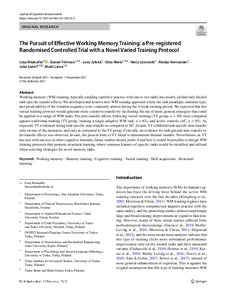The Pursuit of Effective Working Memory Training: a Pre-registered Randomised Controlled Trial with a Novel Varied Training Protocol
Fellman Daniel; Waris Otto; Salmi Juha; Ritakallio Liisa; Lönnroth Nelly; Jylkkä Jussi; Nervander Reidar; Laine Matti
https://urn.fi/URN:NBN:fi-fe2022012710625
Tiivistelmä
Working memory (WM) training, typically entailing repetitive practice with one or two tasks, has mostly yielded only limited task-specific transfer effects. We developed and tested a new WM training approach where the task paradigm, stimulus type, and predictability of the stimulus sequence were constantly altered during the 4-week training period. We expected that this varied training protocol would generate more extensive transfer by facilitating the use of more general strategies that could be applied to a range of WM tasks. Pre-post transfer effects following varied training (VT group, n = 60) were compared against traditional training (TT group, training a single adaptive WM task, n = 63), and active controls (AC, n = 65). As expected, TT evidenced strong task-specific near transfer as compared to AC. In turn, VT exhibited task-specific near transfer only on one of the measures, and only as compared to the TT group. Critically, no evidence for task-general near transfer or far transfer effects was observed. In sum, the present form of VT failed to demonstrate broader transfer. Nevertheless, as VT has met with success in other cognitive domains, future studies should probe if and how it would be possible to design WM training protocols that promote structural learning where common features of specific tasks would be identified and utilised when selecting strategies for novel memory tasks.
Kokoelmat
- Rinnakkaistallenteet [19207]
